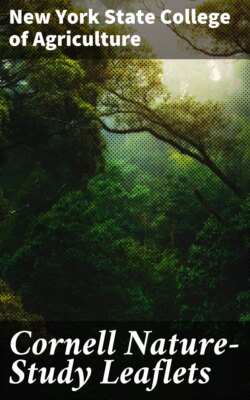Читать книгу Cornell Nature-Study Leaflets - New York State College of Agriculture - Страница 31
На сайте Литреса книга снята с продажи.
Fourth Grade.
ОглавлениеThe object of this year's work may be the teaching of the value of earth, air, light, and water upon plants.
Fall work.—Experiments to show these to be carried on in schoolroom. Experiments to show value of earth to plants:
(1) Plant seeds in fertile earth; poor earth; clean sand or sawdust.
(2) Plant seeds in sawdust and on cotton batting placed on water in a jar.
Experiments to show use of light to plants:
(1) Sow seeds in two boxes of earth prepared just alike. Place one in the window, one in a dark closet, and note results.
(2) Place house plants from greenhouse in a window, and note change of position of leaves.
(3) The story of the sunflower.
Experiments showing use of water to plants:
(1) Place a very much wilted cut plant in water, and note result.
(2) Place seeds in earth which is dry, and in earth which is kept moist.
(3) Plant seeds on batting floating on a tumbler of water, and note results.
These experiments should extend over several weeks.
Winter and spring work.—Begin the study of trees. Choose some tree in the schoolyard, if possible, and make this the basis of the work. The following is an outline for the study of a maple tree: Begin observations in January. Make drawings of the tree, showing the relations of branches to trunk and general outline. Note the following details: The color of trunk and branches in January, and the color in February and March; when the buds begin to swell; the arrangement of buds; watch closely to determine whether a bud develops into a blossom or a leaf; the peculiarities of bark on trunk and branches; do the leaves or the blossoms appear first; the shape and color of the blossoms; draw them and study them thoroughly; the color and position of the leaves when they first appear; draw the different stages of the unfolding of the leaves; keep a calendar of all the year's history of the tree; when in full leaf make another drawing of the whole tree; study the tree from below, and if possible from above, to show arrangement of leaves in reference to light; make drawings of the fruit when it is formed; study how it travels; when the first autumn tints appear; make colored drawings of the tree in its autumn foliage, and note when leaves begin to fall and when the branches are finally bare; note different form of maple in the open and maple in the forest.
In connection with the year's history of the tree, study the tree from an economic point of view. Make a special study of sugar-making in connection with the maple tree. Study maple wood. To do this get a quarter section of a piece of maple log and study the grain lengthwise and in cross sections. Study all the industries possible in which maple is used. Devote one notebook to all the work on the maple tree, and at the end summarize the observations. For drawing of trees, see Cornell Teachers' Leaflet, No. 12 (Nos. XXIX and XXX, this volume). Home Nature-Study, Vol. V, Nos. 2, 5.
